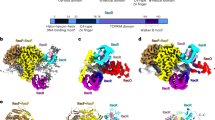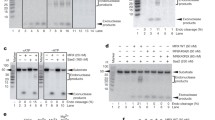Abstract
Archaea have recombination proteins similar to those of eukaryote, but many have not been characterized. Here, the characterization of a Rad55 homologue from Sulfolobus tokodaii (stRad55A) was reported. StRad55A protein preferred binding to ssDNA and had ssDNA-dependent ATPase activity. In addition, UV light could induce the expression of this protein, which was different from RadB, a RadA paralog found in euryarchaeota. Most importantly, stRad55A could release the suppression of excessive stSSB (single strand DNA binding protein from S. tokodaii) on the strand exchange catalyzed by stRadA (RadA homologue from S. tokodaii), by interacting directly with both stRadA and stSSB. StRad55A may function as a mediator to accelerate the displacement of stSSB by stRadA.








Similar content being viewed by others
References
Akiba T, Ishii N, Rashid N, Morikawa M, Imanaka T, Harata K (2005) Structure of RadB recombinase from a hyperthermophilic archaeon, Thermococcus kodakaraensis KOD1: an implication for the formation of a near-7-fold helical assembly. Nucleic Acids Res 33(10):3412–3423
Albala JS, Thelen MP, Prange C, Fan W, Christensen M, Thompson LH, Lennon GG (1997) Identification of a novel human RAD51 homolog, RAD51B. Genomics 46:476–479
Ausubel FM, Brent R, Kingston RE (1995) Short protocals in molecular biology, 3rd edn. Cold Spring Harbor Laboratory Press, New York
Brock TD, Brock KM, Belly RT, Weiss RL (1972) Sulfolobus: a new genus of sulfur-oxidizing bacteria living at low pH and high temperature. Arch Microbiol 84:54–68
Cartwright R, Dunn AM, Simpson PJ, Tambini CE, Thacker J (1998) Isolation of novel human and mouse genes of the recA/RAD51 recombination-repair gene family. Nucleic Acids Res 26:1653–1659
Dosanjh MK, Collins DW, Fan W, Lennon G, Albana JS, Shen Z, Schild D (1998) Isolation and characterization of RAD51C, a new human member of the RAD51 family of related genes. Nucleic Acids Res 26:1179–1184
Fortin GS, Symington LS (2002) Mutations in yeast Rad51 that partially bypass the requirement for Rad55 and Rad57 in DNA repair by increasing the stability of Rad51–DNA complexes. EMBO J 21:3160–3170
Grogan DW (2000) The question of DNA repair in hyperthermophilic archaea. Trends Microbiol 8(4):180–184
Hashimoto K, Yonesaki T (1991) The characterization of a complex of three bacteriophage T4 recombination proteins, uvsX protein, uvsY protein, and gene 32 protein, on single-stranded DNA. J Biol Chem 266:4883–4888
Johnson RD, Symington LS (1995) Functional differences and interactions among the putative RecA homologs Rad51, Rad55, and Rad57. Mol Cell Biol 15:4843–4850
Komori K, Miyata T, DiRuggiero J, Holley-Shanks R, Hayashi I, Cann IK, Mayanagi K, Shinagawa H, Ishino Y (2000a) Both RadA and RadB are involved in homologous recombination in Pyrococcus furiosus. J Biol Chem 275(43):33782–33790
Komori K, Miyata T, Daiyasu H, Toh H, Shinagawa H, Ishino Y (2000b) Domain analysis of an archaeal RadA protein for the strand exchange activity. J Biol Chem 275:33791–33797
Lee MH, Leng CH, Chang YC, Chou CC, Chen YK, Hsu FF, Chang CS, Wang AH, Wang TF (2004) Self-polymerization of archaeal RadA protein into long and fine helical filaments. Biochem Biophys Res Commun 323:845–851
Liu N, Lamerdin JE, Tebbs RS, Schild D, Tucker JD, Shen MR, Brookman KW, Siciliano MJ, Walter CA, Fan W, Narayana LS, Zhou ZQ, Adamson AW, Sorensen KJ, Chen DJ, Jones NJ, Thompson LH (1998) XRCC2 and XRCC3, new human Rad51-family members, promote chromosome stability and protect against DNA cross-links and other damages. Mol Cell 1:783–793
Lovett ST (1994) Sequence of the RAD55 gene of Saccharomyces cerevisiae: similarity of RAD55 to prokaryotic RecA and other RecA-like proteins. Gene 142(1):103–106
Miyazaki T, Bressan DA, Shinohara M, Haber JE, Shinohara A (2004) In vivo assembly and disassembly of Rad51 and Rad52 complexes during double-strand break repair. EMBO J 23(4):939–949
New JH, Sugiyama T, Zaitseva E, Stephen C Kowalczykowski SC (1998) Kowalczykowski.\ Rad52 protein stimulates DNA strand exchange by Rad51 and replication proteinA. Lett Nat 391:407–409
Reich CI, McNeil LK, Brace JL, Brucker JK, Olsen GJ (2001) Archaeal RecA homologues: different response to DNA-damaging agents in mesophilic and thermophilic archaea. Extremophiles 5(4):265–275
Ries G, Buchholz G, Frohnmeyer H, Hohm B (2000) UV-damage-mediated induction of homologous recombination in Arabidopsis is dependent on photosynthetically active radiation. Proc Natl Acad Sci USA 97:13425–13429
Salerno V, Napoli A, White MF, Rossi M, Ciaramella M (2003) Transcriptional response to DNA damage in the archaeon Sulfolobus solfataricus. Nucleic Acids Res 31:6127–6138
Seitz EM, Brockman JP, Sandler SJ, Clark AJ, Kowalczykowski SC (1998) RadA protein is an archaeal RecA protein homolog that catalyzes DNA strand exchange. Genes Dev 12:1248–1253
Sheng D, Liu R, Xu Z, Singh P, Shen B, Hua Y (2005) Dual negative regulatory mechanisms of RecX on RecA functions in radiation resistance, DNA recombination and consequent genome instability in Deinococcus radiodurans. DNA Repair (Amst) 4:671–678
Shinohara A, Ogawa T (1998) Stimulation by Rad52 of yeast Rad51-mediated recombination. Nature 391:404–407
Singleton MR, Wentzell LM, Liu Y, West SC, Wigley DB (2002) Structure of the single-strand annealing domain of human RAD52 protein. Proc Natl Acad Sci USA 99(21):13492–13497
Stasiak AZ, Larquet E, Stasiak A, Muller S, Engel A, Van Dyck E, West SC, Egelman EH (2000) The human Rad52 protein exists as a heptameric ring. Curr Biol 10:337–340
Sugiyama T, Stephen C (2002) Rad52 protein associates with replication protein A (RPA)-single-stranded DNA to accelerate Rad51-mediated displacement of RPA and presynaptic complex formation. J Biol Chem 277:31663–31672
Sung P (1997) Yeast Rad55 and Rad57 proteins form a heterodimer that functions with replication protein A to promote DNA strand exchange by Rad51 recombinase. Genes Dev 11:1111–1121
Sweezy MA, Morrical SW (1999) Biochemical interactions within a ternary complex of the bacteriophage T4 recombination proteins uvsY and gp32 bound to single-stranded DNA. Biochemistry 38:936–944
Symington LS (2002) Role of RAD52 epistasis group genes in homologous recombination and double-strand break repair. Microbiol Mol Biol Rev 66:630–670
Takata M, Sasaki MS, Tachiiri S, Fukushima T, Sonoda E, Schild D, Thompson LH, Takeda S (2001) Chromosome instability and defective recombinational repair in knockout mutants of the five Rad51 paralogs. Mol Cell Biol 21:2858–2866
Thacker J (1999) A surfeit of RAD51-like genes? Trends Genet 15:166–168
Wolner B, van Komen S, Sung P, Peterson CL (2003) Recruitment of the recombinational repair machinery to a DNA double-strand break in yeast. Mol Cell 12:221–232
Acknowledgments
This work was supported by the National Basic Research Program of China (2004CB719604) and National Natural Science Foundation of China (30470386 and 30700011).
Author information
Authors and Affiliations
Corresponding author
Additional information
Communicated by J.N. Reeve.
Electronic supplementary material
Below is the link to the electronic supplementary material.
792_2007_113_MOESM1_ESM.doc
Appendix Figure Phylogenetic analysis based on the entire amino acid sequences of the Rad51/RadA and their paralogs from Arabidopsis thaliana, Halobacterium salinarum, Homo sapiens, Methanococcus jannaschii, Natronomonas pharaonis, Pyrococcus furiosus, Saccharomyces cerevisiae, Sulfolobus solfataricus, and Sulfolobus tokodaii. The sequences were obtained from GenBank and followed by a multiple sequence alignment by ClustalX. The phylogenetic tree was inferred from the alignment information using parsimony method. (DOC 122 kb)
Rights and permissions
About this article
Cite this article
Sheng, D., Zhu, S., Wei, T. et al. The in vitro activity of a Rad55 homologue from Sulfolobus tokodaii, a candidate mediator in RadA-catalyzed homologous recombination. Extremophiles 12, 147–157 (2008). https://doi.org/10.1007/s00792-007-0113-y
Received:
Accepted:
Published:
Issue Date:
DOI: https://doi.org/10.1007/s00792-007-0113-y




